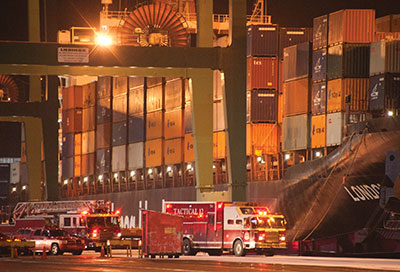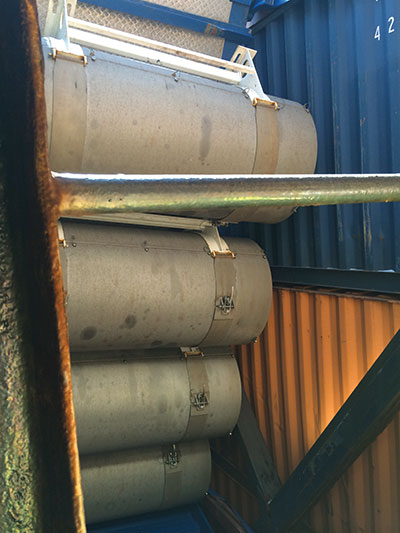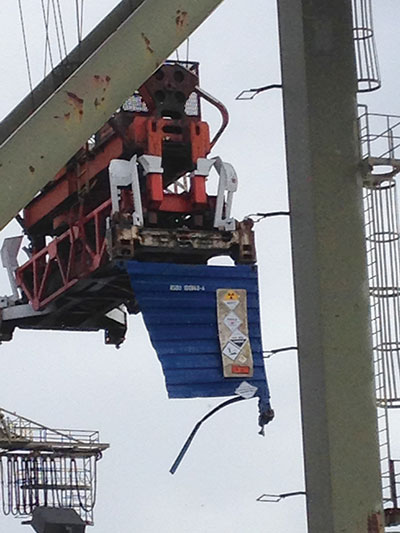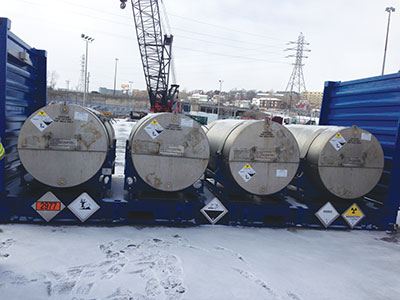
Features
Hot topics
Incident reports
Radiation scare
In Halifax, it takes between 60 and 90 seconds for a 911 call taker to answer the phone, pass the phone to a fire dispatcher and tone out the necessary apparatuses.
April 24, 2014
By John Giggey
In Halifax, it takes between 60 and 90 seconds for a 911 call taker to answer the phone, pass the phone to a fire dispatcher and tone out the necessary apparatuses. Sometimes, when the call is particularly serious, one dispatcher may telephone the primary station to give crews a heads up while another dispatcher handles the page.
 |
|
| Halifax Regional Fire and Emergency Services responds to a call for a possible radiation leak at a container pier on March 13. Containers holding uranium hexafluoride, a highly radioactive compound used in the uranium enrichment process that produces fuel for nuclear reactors and nuclear weapons, had been dropped by a crane into the ship’s hold and had possibly been compromised. Photo by Andrew Vaughan, The Canadian Press
|
So when the house phone rang at Station 12 shortly after 9:30 p.m. on March 13, Capt. Ed Oakley knew something was up.
The dispatcher told Oakley that a crane had dropped several canisters containing radioactive material. The canisters fell about 15.24 metres (50 feet) at the Cerescorp container pier, one of two container piers on the Halifax waterfront. While the dispatcher was still talking, the tones started.
The response included the city’s hazmat units –12 Company, comprising Quint 12 and Tactical 12, and Quint 5, the decontamination unit, which is based in another part of the city. A hazmat response also includes the closest engine company, which in this case, was also from 12 Company, as well as the closest engine company, Engine 4, which was just up the street from the scene.
In Halifax, the operating guidelines for a radiological response require that personal dosimeters (which measure radiation exposure) be activated and donned by all hazmat crew members before leaving the station. A Geiger-Mueller probe, which is sensitive to alpha, beta and gamma radiation, must be activated and its readings must be monitored during the response. Any other meters expected to be used must be up and running before the apparatuses leave the station. For this reason, the hazmat units at both stations were delayed four or five minutes.
 |
|
| The part of the flat rack with the canisters still attached landed on its end, with the top canisters leaning forward. The danger of a collapse kept members from approaching the canisters to get a required reading three feet from the containers. Photo by Mark Legere |
First-in Engine 4 arrived on scene to find security waiting. Capt. Dennis Pitts met the night superintendent who told him the canisters fell about 12.2 metres (40 feet) into the hold of a container ship. The department later learned that the containers actually fell about 6.1 metres (20 feet) while being off-loaded. Four canisters had been bolted to a flat rack, which is constructed of a steel frame and a softwood bottom. An identical rack of canisters on the nearby wharf had just been off loaded, and carried the same product. Pitts determined the canisters were marked UN2977 – uranium hexafluoride, a highly radioactive compound used in the uranium enrichment process that produces fuel for nuclear reactors and nuclear weapons.
Pitts radioed that information to Oakley on the quint, who later said the hairs on the back of his neck stood up when he spoke with Pitts. A few weeks earlier, he had drilled his crew on a worst-case scenario involving a radioactive spill, and that very scenario was playing out. Oakley advised Pitts to not proceed any further and to hold his position until the hazmat team arrived. Once on scene, Oakley spoke face to face with Pitts and assumed command.
Operating guidelines require the staging area first be metered to confirm it is in the cold zone. After this was completed, two members geared up and, using meters, moved forward from the apparatus toward the incident, monitoring for changes in levels. There were none.
“We got right up to the ship without any significant readings,” Oakley said. “Now we could narrow the hot zone down to the ship itself.
“We didn’t board the ship at this point, but we could communicate with the crew from the jetty. We determined there were four canisters attached to the flat rack, and part of the rack along with the canisters had fallen into the hold.”
In the meantime, Pitts gathered information in the main Cerescorp building at the terminal. Then came a surprise: the shipping agent approached Pitts and reported that everything was fine. The agent said that he and the first mate had already gone into the hold, inspected the containers and determined that nothing was wrong with them.
There’s a little more to checking for radiation than looking. Pitts put into isolation the shipping agent and everyone with whom he had come into contact. Pitts also isolated himself from his crew until he could be metered. With the first mate still on the ship, the crew also had to be checked. The gates to the pier were closed and no one was allowed to leave or enter without permission from fire officials. Everyone was later metered and cleared of any radiation contamination.
 |
|
| Part of the flat rack remains on the crane after another section with the canisters attached fell into the hold. Photo by Scott Logan
|
By this time, Divisional Commander (platoon chief) Corey Beals had arrived and assumed command. Oakley was put in charge of operations. Pitts gathered all stakeholders on scene in a boardroom and Beals, having been brought up to speed, briefed them on what was happening. Oakley updated the group on the operational side via cell phone.
With a potentially major incident unfolding, Beals called for the emergency management team, bringing together Fire Chief Doug Trussler, Brian Gray, the deputy chief of operations, and Roy Hollett, the deputy chief of operational support, along with Executive Officer Phil McNulty as public information officer. By this time, many reporters had gathered outside the gate.
The need for an official public information officer on scene had become critical. Because divisional commanders often deal with the media on day-to-day calls, it’s not uncommon for reporters to have their contact information. This call was now well beyond routine, and phone inquiries were flooding in from all over North America and around the world. With a PIO in place, the incident commander could manage the incident without distraction.
At any given time, the level of radiation from various sources fluctuates around 0.25 uSv/hr, or one quarter of one millionth of a sievert. This product was contained in cement with a steel outer casing, making it virtually indestructible. This type of vessel is considered category-3 containment. Each of the four canisters involved weighed about 4.5 tonnes.
Halifax Regional Fire and Emergency Services guidelines allow for members to advance until they get readings of 0.5 uSv/hr, still far below any danger level. Using this measurement as a guide, pylons are set down at the 0.5 uSv/hr point around the source, cordoning off an area that becomes the initial contact point.
In this case, scene control was manageable given that the incident was aboard a ship. Following the directions provided by a member of the ship’s crew, firefighters Craig March and Sherry Thibault boarded the ship, taking meter readings as they went. Oakley and firefighter Dwayne Dodge followed March and Thibault, using meters for a secondary survey. The meter readings remained at normal levels.
March and Thibault climbed to a catwalk overlooking the hold and had a visual on the dropped containers, 6.1 metres (20 feet) below. Radiation readings always fluctuate, but the meters read about four times normal levels.
“Dwayne and I went up and confirmed the levels with our meters,” Oakley said. “But at that point we had no idea what would be normal for that container.”
Meanwhile, Beals notified outside agencies, including the Canadian Transport Emergency Centre (CANUTEC) and the Canadian Nuclear Safety Council, advising them of a potential incident involving uranium hexafluoride and indicating that first responders were still investigating.
 |
|
| An identical flat rack of canisters with the same product sits on the wharf after being off-loaded before the second rack fell back into the ship. Photo by Cory Dominix |
However, satisfied with the readings, crews narrowed the hot zone to the area around the canisters. Further investigation showed that if uranium hexafluoride mixes with water, it forms deadly hydrofluoric acid in a gaseous state. CANUTEC advised that most crew members be evacuated, leaving only the captain and four seamen aboard.
Oakley maintained contact with CANUTEC and obtained the emergency response action plan for the product from RBS Logistics, the emergency response agency for these canisters. RSB Logistics also provided Oakley with the consignment papers for that product, which included other specific information on what crews were dealing with.
Oakley also received the transport index. This was critical; the index says precisely what the maximum reading should be for the canister from a distance of one metre (three feet). If readings exceed that level, the canister has lost its ability to safely hold the product. At this point, crews needed to take readings one metre away from the canisters.
However, the rack of canisters had fallen vertically into the hold; the canisters were leaning forward and it was obvious they could fall over. Firefighters could not safely get within one metre of the canisters to take a reading.
The decision was made to leave only a skeleton crew of the captain and two other critical officers on board. A department portable radio was left with the officers on board so they could contact command directly if necessary.
With the situation now stable, Engine 4 and Quint 5 were released. Since there was still a chance the rack could fall over, Quint 12 and Tactical 12 stayed on scene. At daybreak, a shift change resulted in Divisional Commander Peter Andrews taking over incident command and Capt. Scott Logan of 12 Company taking over operations after being briefed by Oakley.
In the meantime, a remote camera had been set up to provide a live video feed to the tactical unit so the canisters could be monitored constantly without firefighters being close to the scene. Every 90 minutes, a member would go and change the battery.
During the day, officials arrived from the Canadian Nuclear Commission, RSB Logistics, and Overwatch Incorporated, a company that specializes in the nuclear industry including responding to and mitigating nuclear emergencies. It was critical to get that one-metre reading. But the problem remained: The four canisters were on their ends and leaning forward; they could topple over at any time. Putting someone next to them to take a reading was out of the question.
It was time to innovate. As a hazmat scene, there had been a pole set up with a sock on top to monitor wind direction. Members removed the sock, attached a meter to the pole, and took the reading from a safe distance. The readings were within the transport index; the canisters were safe; the emergency, basically, was over.
Fire crews stayed on scene until industrial response teams arrived from outside the province. A camera was set up, which allowed members to constantly monitor the canisters from Tactical 12.
“By 11 p.m. we had determined there was no leakage, the integrity of the containers had not been compromised, and the containers could be moved the following day,” said Andrews.
At 21 minutes after midnight on March 15, Company 12 cleared the scene and the incident officially came to an end.
Lessons Learned
- HRFE is considering putting cellular devices with Internet access on frontline apparatuses, in addition to the computer system in its tactical unit. In the meantime, some members have acquired personal devices, which proved valuable during this operation. With the incident at a distance from the tactical unit, members could quickly access online information without returning to the vehicle. Members could also communicate by cell phone rather than radio transmissions, which are monitored by the media and the public.
- iPhones provide much better live video feeds than the department’s expensive remote camera.
- Carefully choose your words. While prolonged exposure to radiation readings of four times normal levels can cause health problems, this reading posed no immediate danger yet caused great concern among uninformed reporters and the listening public. Use more face-to-face or mobile-phone communication.
- Provide a separate, quiet location for the hazmat research team. The team was in the same vehicle as accountability, which was loud, crowded and distracting.
- Command could have stayed with the first-in captain until a more senior officer arrived so the captain of the hazmat team could focus on his assignment.
John Giggey is a retired volunteer captain with Halifax Regional Fire. He works part-time in the department’s public affairs division. He is also a retired journalist, having acted as a supervising editor with the Canadian Press and Broadcast News in Toronto. E-mail him at giggeyj@halifax.ca
Print this page